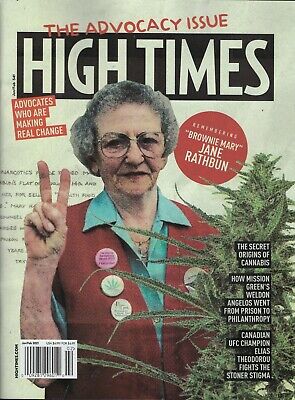One of California’s most influential cannabis activists started her journey right here in the Castro district – a woman lovingly known as “Brownie Mary.” When the AIDS epidemic began to wreak havoc in San Francisco, Mary Jane Rathbun — AKA “Brownie Mary,” provided thousands of cannabis-infused brownies to those suffering and in pain. Her life was dedicated to activism, and her tireless efforts profoundly impacted the fight for cannabis legalization and equal rights for the LGBTQIA community.
The Life of Brownie Mary
At 13 years old, Mary left home and showed her displeasure at the establishment by striking back at a nun who was caning her at Catholic school. She became a waitress and independently supported herself throughout her adolescence and early adulthood when she moved to San Francisco. It was here that she met, married, and divorced her husband – with whom she had a daughter named Peggy.
Mary remained independent, continuing to waitress until her daughter died in 1974. Her daughter was only 22 when she was tragically killed by a drunk driver. After this devastating event, Mary realized she needed to start saving for her future. So she began selling pot brownies to make money and provide for herself later in life.
As a San Francisco General Hospital volunteer, Mary met many AIDS patients. These individuals were not only struggling with a new and deadly disease but also with the pain that came with it. So she soon began baking brownies for AIDs patients — brownies laced with cannabis. She said she would bake around 500 brownies per week to give patients free of charge.

Hundreds of Brownies Every Week
From her apartment in Castro, she spent the next few years baking hundreds of cannabis-infused brownies every week, selling them by the dozen. Her method of passing out flyers that advertised “magically delicious” brownies eventually earned her a visit from an undercover cop in 1981. This would be the first of 3 separate arrests, and each time Brownie Mary would go straight back to baking and providing her famous brownies to the local community, unfazed and undeterred.
Her punishment for the initial arrest was 500 hours of community service, which she served at the Shanti Project — one of the first organizations to help those suffering from symptoms of AIDS. It was here that she became aware of how HIV/AIDS patients were being shunned by the medical mainstream.
As AIDS continued ravaging her community and those of her friends, Mary began volunteering at San Francisco General Hospital, where overcrowded AIDS wards were neglected due to the stigma and ignorance surrounding the disease.
Medical Marijuana Movement & the AIDS Epidemic
During this time, Mary began compassionately sneaking patients her brownies, hoping to ease their pain and minimize their suffering. The cannabis in the brownies kept their nausea at bay while stimulating their appetite and soothing their aches. As many initial AIDS medications and treatments were causing unpleasant side effects, Mary’s brownies were a welcome alternative.
Brownie Mary’s compassion knew no bounds – when she started giving away her marijuana brownies instead of selling them, she was using her measly social security checks to buy baking ingredients and relying on donations of cannabis from generous growers.
Brownie Mary unintentionally demonstrated the medicinal purposes and capabilities of cannabis very effectively by allowing people in need access to it, demonstrating how beneficial the plant could be when utilized correctly to the rest of the world.

The Healing Properties of Cannabis
Brownie Mary volunteered in these wards during the late 1980s and early 1990s, when anti-cannabis rhetoric was very popular, with constant propaganda about cannabis being harmful. What Brownie Mary was displaying in her defiance was the exact opposite — here were a group of people all suffering from the same horrible AIDS symptoms, and cannabis proved to be very beneficial for many of them.
When she was arrested for the second time during a brownie delivery to a cancer patient in 1992. She stood before the San Francisco Board of Supervisors and explained the medical benefits of cannabis. Her impassioned testimony influenced the Board to virtually decriminalize cannabis, making it their lowest priority for arrests and prosecution.
When cannabis became legal for medical use in California in 1996, it was in no small part thanks to Brownie Mary demonstrating the effectiveness of the plant’s medicinal qualities with her AIDS and cancer patients. In addition, she was promoting the same pain-relieving, appetite-stimulating and sleep-inducing qualities that researchers have repeatedly verified.
The Advancement of Medical Treatments for AIDS
Meanwhile, HIV/AIDS has become much more manageable than during the epidemic. If someone discovers they have contracted HIV/AIDS in the modern day, there is a prescription medicine that allows them to continue living their life with little disruption.
The first medications and treatments were not especially effective and caused seriously unpleasant side effects, which is why cannabis was such a valuable tool in that fight. Then, in 1995, a medication of protease inhibitors finally found a suitable formula and managed to get the crisis under control.
As if to validate the work of Brownie Mary and her fellow pioneers, a landmark piece of research brought the two worlds together in 2003, establishing the beneficial effects of cannabis on the immune systems of AIDS patients.
Brownie Mary and Dennis Peron
California’s Proposition 215 was passed in 1996, making cannabis use legal for approved medical conditions. It was a truly historic law, the first of its kind anywhere in America. Soon after, other states began passing their own versions of medical cannabis laws as more and more people became aware of the plant’s healing properties. Fast forward to 26 years later, we now have 37 states, Guam, Puerto Rico and the District of Columbia allowing various versions of medical cannabis access.
That first law passing in California was driven by the work and passion of pioneering activists, none more so than two of Castro’s finest — Brownie Mary and her close friend Dennis Peron.
A Castro District Friendship
Mary and Dennis first met in the Castro district, sharing a joint across the street in the Flore Cafe! Besides joints, they also shared a similar philosophy around social activism and quickly became friends, with Peron selling Mary’s brownies at his Big Top cannabis market on Castro Street. Two prominent names in cannabis culture working together to make a difference.
During the same period that Brownie Mary was helping in the AIDS wards, Dennis Peron was educating AIDS advocacy groups on the therapeutic benefits of cannabis. Initially, the groups were hesitant, but after inviting his friend Mary to share her first-hand experiences of providing cannabis for AIDS patients, she and Dennis began shifting the perception of cannabis for the better.
Their valiant efforts were also fundamental to helping Castro become the vibrant gay community it still is today by countering the stigma and ignorance around AIDS with their activism and compassion. Knowing their impact on our neighborhood, it is impossible for us not to celebrate and recognize Dennis and Mary whenever we can.
Cannabis Laws & Regulations
Although Proposition 215 was their most significant victory, Brownie Mary and Dennis Peron set the tone for passing that law with Proposition P in 1991. The proposition requested that cannabis be reinstated to the list of available medicines in California and that any physicians recommending cannabis could do so without losing their medical license. Voters overwhelmingly approved it on the ballot, with 80% in favor of the proposition.
This, along with Mary’s showing at the San Francisco Board the following year, ensured that cannabis was the lowest priority for local law enforcement. The success of Proposition P was the perfect proof of concept for the subsequent Proposition 215 in 1996, which was soon copied in Alaska, Washington, Oregon and Hawaii.
The Momentum of State-Legal Cannabis
As of now have, 37 states with medical cannabis access, while 19 states have made recreational cannabis legal too. The wave of states legalizing adult use cannabis still continues, with at least another 3 states considering legalization on the 2022 ballot. Most of this has taken place in the last decade and began when Washington and Colorado became the first states to pass bills in 2012. Oregon and Alaska followed in 2014, with California, Nevada, Massachusetts and Maine joining them in 2016.
While the momentum of all these states is promising, cannabis advocates know that it can all be undone by the Federal government, which outranks any state laws. It’s sadly ironic that the Federal government still classifies cannabis as a Schedule 1 controlled substance. This category is for substances considered to have a high potential for abuse and no known medical value, but this couldn’t be further from the truth when it comes to cannabis.
The Controlled Substance Act Conundrum
Cannabis was arbitrarily placed in this category in 1970 when the Controlled Substances Act was created. Unbelievable as it may sound, it remains there to this day, and until we can secure decriminalization from the Federal lawmakers, cannabis and the industry around it will be stifled. Due to this Schedule 1 classification that cannabis companies cannot get adequate access to banking or deduct their overhead costs of operating in the same way that other consumer goods companies can.
We still have so many non-violent offenders in prison for a plant that others can now legally profit from. In addition, the Schedule 1 categorization had for years prevented research on any potential benefits of cannabis. This is because researchers cannot easily study controlled substances – most research on controlled substances that receives funding was required to look for cannabis’ harms and negative effects.
Thankfully, times have changed, and there is a more balanced approach to current research, but we still need the laws to change so we can see the full potential of the cannabis plant and market. As the various statewide efforts continue and grow, we are hopeful that a Federal government will see sense in finally overturning the ruling on cannabis.
The Legacy of Brownie Mary
During her time in San Francisco, Brownie Mary, a true marijuana activist, inspired those around her to devote their energy to causes they were passionate about. After her arrests, she became world-renown for her compassion, and her approach was replicated across America and beyond.
Although she passed away in 1999, her legacy continues to grow as cannabis becomes more normalized. Her name is rightly one of the first to be mentioned when discussing how cannabis came to be legal in California, and it is a core part of our mission at Flore to amplify her message and the awareness of her work.
As a tribute to her hard work, Mary Jane Rathbun is memorialized in what is known as Brownie Mary Day. On August 25th, we remember her by celebrating all she did for the cannabis community. We also eat a pot brownie in her honor, of course! You can join the festivities by making your own brownies at home using Brownie Mary’s Marijuana Cookbook. These brownies are sure to make you feel good, just like Mary Jane!
Flore’s Promise to the Cannabis Community
Brownie Mary was a helping hand and a voice for AIDS patients in our community when they were most ostracized and neglected by mainstream medicine. Flore’s inspiration to do the same comes directly from Brownie Mary and Dennis Peron. We aim to uplift marginalized communities by supporting local farmers and being a safe space for the LGBTQIA community in Castro.
We love providing our beautiful district with the best sun-grown cannabis flower and sharing the stories of the farmers alongside celebrating the work of pioneers like Brownie Mary and Dennis Peron, that paved the way for us to carry on their vision in the 21st century. Stop by or order online and say hi — we would love to share some brownies with you!


